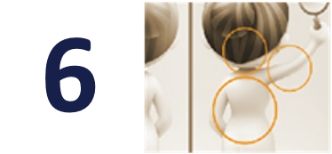2014 Kampanja

To watch this video you need to accept third-party cookies (Marketing).
If you cannot view the video, please click here
Euromelanoma u BIH 2014
Plesom protiv raka kože - melanoma
Sarajevo, 10.05.2014

To watch this video you need to accept third-party cookies (Marketing).
If you cannot view the video, please click here
Dear healthcare professional,
You see more of your clients’ skin than they see themselves. You are therefore ideally placed to identify potentially dangerous skin spots before they become a problem. So if you see something suspicious, be sure to recommend that your client sees a dermatologist. It could prevent serious health problems and may even save their life.
The leaflet below explains what to look for.
For more information about the different kinds of skin spots, what they mean and how they can be treated, you can also refer them to our main website: www.euromelanoma.org
Thank you for joining the fight to prevent skin cancer.
Download, read and share.
We have prepared educational materials. You will find useful advices.
Feel free to download these documents and share them with your family, friends, colleagues...
People are traveling in your offices, lounges, corridors, health club, shops, waiting rooms?
Your job will take you to see, touch or take care of the skin of your clients? Do not miss out of danger.
Preventing skin cancer
Skin cancer can be seen, and knowing your skin can make the difference. Check yourself regularly and look for changes, because skin cancer can be treated if caught early enough. Always consult your dermatologist in case of doubt.
Always be sunsafe
Avoid unnecessary exposure.
Seek shade where possible, and avoid the summer sun during the middle of the day.
Wear protective clothing
Include dark colours, long sleeves, a widebrimmed hat and UV-rated sunglasses.
For children, look for clothing with inbuilt sun protection.
Apply sunscreen
Check that yours has a high protection factor against both UVA and UVB rays. Remember that sunscreen takes effect around half an hour after its application and only lasts for two to three hours.
Protect children
Children are at the greatest risk of long-term health issues related to unsafe sun exposure.
Outside play is important, but you should never let a child get sunburnt.
Everyone has skin spots. They are a perfectly normal part of growing up and growing older.
However, every now and again, they may be a warning of something more dangerous.
So be sure to check your skin regularly for suspicious looking spots. If in doubt, consult your dermatologist.
Check your own skin and that of your loved ones once a month. Be on the lookout for spots that:
- Change size, colour and/or shape
- Look different to the others
- Are asymmetrical
- Feel rough or scaly, sometimes you can feel
- the lesions before you can see them
- Are multi-coloured
- Are itchy
- Are bleeding or oozing
- Look pearly
- Look like a wound but do not heal
Look for the warning signs of skin cancer. Consult your dermatologist if you see two or more.
Because melanoma is particularly serious, you should be familiar with the signs to look for.
The ABCDE of melanoma can help you to detect it early:
A. Is the spot asymmetric?
B. Does it have uneven borders?
C. Does it contain different colours?
D. Is it larger than 6mm in diameter?
E. Is there an evolution in growth?
Melanoma
This is the least common form of skin cancer, but also the most dangerous. It can affect people of any age, unlike other types that are more common among older people.
It presents as a spot that becomes darkly pigmented or develops irregular edges or different colours over time, or as a rapidly-growing pink or red lump. It can spread internally, so immediate treatment is required.
Basal cell carcinoma
This is the most common form of skin cancer, but also the least dangerous. It typically presents as an elevated skin-coloured lump with a shiny, pearl-like edge, a wound that does not heal, or a slightly crusty lump that grows slowly over time. If left untreated, it may ulcerate and invade deeper tissues.
Squamous cell carcinoma
This is the second most common form of skin cancer, occurring in areas of the skin that have had a lot of sun exposure, such as the face and scalp. It presents as a crusty lump which may grow quickly and become ulcerated and weepy. It can spread rapidly, especially if on the lips, ears, fingers and toes, or in immunosuppressed patients. Surgical treatment to remove the lesions is essential.
Actinic keratosis
This occurs most commonly in middle-aged and elderly people, on areas most exposed to the sun such as the face, neck, ears, back of the hands and scalp. It presents as red-brown scaly and rough patches of skin. The lesions are pre-cancerous; in 10– 15% of cases they may develop into squamous cell carcinomas, so they should be treated to prevent progression.
Download and print the table of 23 lesions
Skin cancer can affect anybody at any age. It is most common in people over 50, or people who have had prolonged exposure to the sun.
You are at higher risk if you:
• Have fair skin or are prone to sunburn
• Were sunburnt during childhood
• Have spent a lot of time in the sun (for work or leisure)
• Have periodical exposure periods (e.g. on holidays)
• Use sunbeds
• Have more than 50 moles
• Have a family history of skin cancer
• Are over the age of 50
• Have undergone an organ transplant
Whether you’re in a high-risk group or not, there are simple things you can do now to protect you and your family from skin cancer.
By protecting your skin, checking yourself regularly and knowing the signs, you can stop any suspicious skin lesions before they become something more serious.
Check your skin once a month for any changes or suspicious-looking spots.
Your check should cover your whole body, front and back, with particular emphasis on areas exposed to the sun.
Stand in front of a full-length mirror with a hand mirror for those hard-to-reach places.
1. Look at your face, including your nose, lips, mouth and on and behind your ears.

2. Check your scalp, using a comb to part your hair. If you do not have much hair, check your entire scalp very thoroughly.

3. Check the front and back of your hands and in between your fingers.

4. Then focus on your neck, chest and upper body. Women, be sure to check between and underneath your breasts.

5. Bend your elbow to check your upper arm and armpits.

6. Use your hand mirror to check the back of your neck and your back, top and bottom.

7. Check your buttocks and the back of your legs. Finish by checking the soles of your feet and in between your toes.

How to prevent skin cancer
Use your common sense when in the sun to minimise the risk of skin cancer.
Tips:
- Maximize protection measures for children (regular use of a high sun protection factor sunscreen (30 to 50), shirt and hat).
- Reapply sunscreen every two hours.
- Avoid sunbeds and tanning booths.
- Seek shade and stay out of the sun at its strongest (between 11am and 4pm).
- Protect your skin and eyes (hat, shirt, sunglasses).
- Don’t let your skin go red in the sun: avoid sunburn!
- Ensure you check your skin regularly, and visit your doctor or dermatologist if you find anything unusual.
For more information about the different types of skin spots and what they mean, visit our website: www.euromelanoma.eu




















